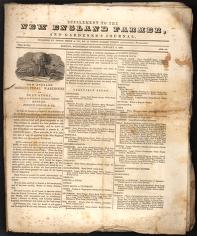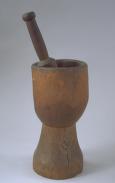|

"Supplement to the New England Farmer, and Gardener's Journal"

List of plants in the garden of William Stoddard Williams

Mortar and Pestle
|
Summary and Objective
The student will compare and contrast home gardens today to kitchen gardens in the 19th century. During the Expansion period, families usually had a garden that included herbs, fruits, flowers, and vegetables. The student will understand that New England gardens were important during this period.
Teaching Plan
Step 1.
Pre-activity. In small groups, have students share information about their own gardens: Who has a garden, where it is located, who takes care of it and why they have a garden. The students will then record what is grown in their own gardens under the headings:fruit,vegetable,herb,flower.
Step 2.
In a large group, students will share their information from pre-activity. Teacher will record a class list of items grown in present-day gardens. Ask the students the following questions: 1)Do you think the same types of items were grown in gardens during the Expansion period? 2) Where would people get seeds needed to plant gardens during the Expansion period? 3) What tools/items might be used related to kitchen gardens?
Step 3.
Click on the picture, "Supplement to the New England Farmer, and Gardner's Journal" and locate plants listed from page one that would be used in kitchen gardens during the Expansion period. Then click on list of plants in garden of William Stoddard to locate more plants used in gardens during this period. After viewing both images compare/contrast the garden plants used in New England during the Expansion period to the class list of garden items.
Step 4.
Click on the picture, Mortar and Pestle and ask the students the following questions: 1)Does anyone know the name of this tool? 2)What natural resource was needed to make this tool? 3) How might this tool be used in the kitchen? Then, elicit from the students possible reasons for growing herbs and flowers in a garden. Explain how herbs and flowers were tied in bunches and hung to dry. After they were dried, they could be crushed with this tool called a mortar and pestle. Then the crushed herbs and flowers were stored in cloth bags. Provide additional information so the students understand a variety of uses for flowers and herbs during the Expansion period. Herbs like dill, savory, and thyme were used to flavor food. Herbs and spices could also be collected in small cloth bags called sachets. They were used to give a room a pleasant aroma. Petals from roses might be used for cooking or to make lotion. Explain how herbs and flowers were also used for medicine. For example, marigolds were used for headaches and mint for stings.
Step 5.
Post-activity. Students will grow their own herbs in class. They will take their herbs home to use in their kitchen. Another post-activity is to have students make paper bags for storing dried herbs. Fold a piece of brown paper in half, use string to stitch across the bottom and up one side.
|




